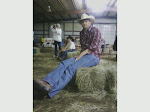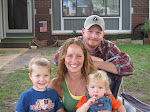As many know, the practice of burning off pasture land keeps certain weeds and shrubs from choking out the nutritive grasses that livestock need to graze on. Burning also promotes healthy growth of the native grasses. Farmers and ranchers burn patures everys spring using water trucks and torches. They burn the edges of the pastures first to create a barrier. Then they move to the center and light fires in rows, starting on one end of a pasture and gradually working backwards. They keep water trucks on both sides of the burning to prevent backfires and dangerous situations. Occasionally, fires can get out of hand. You are required to apply for burning permits. Before the burning starts you have to check to see if there is a red flag warning due to prairie winds and the humidity level of that day. Sadly, yesterday, there were two ranchers south of us about 40 miles, whose fires got out of control. When they realized the fire was out of their control they got in their pickup and tried to get to safety. Their pickup truck got stuck in fencing. Tragically, the fire overran them and engulfed their pickup. One rancher lost his life after bein life-flighted to Wichita's burn unit and the other is in fair condition suffering from severe burns. Here are the details as posted in the news:
Posted on Wed, Apr. 08, 2009 in the Wichita Eagle Newspaper
Two hurt in Cowley County grass fire
Two people were burned -- one critically -- in a grass fire that broke out this afternoon in Cowley County.
The Winfield Fire Department said the fire was reported about 1 p.m. southeast of Winfield after what started as a controlled burn got out of hand.
Firefighters said one person was flown by air ambulance to the burn unit at Via Christi Medical Center-St. Francis Campus. The second victim was taken from the scene by ambulance. Neither victim was a firefighter.
The fire was one of several grass fires reported in south-central Kansas this afternoon, but no other injuries were reported.
Posted on Wed, Apr. 08, 2009
Kan. pasture fire kills rancher
The Associated Press
DEXTER, Kan. - What was supposed to be a controlled burn of pastureland has taken the life of a rancher in south-central Kansas. A second rancher was injured.
Winfield Fire Chief Curtis Wilson said the two men were burning off a field near Dexter on Wednesday when the flames got out of control.
The men drove away, but the fire overtook their pickup truck.
One of the men was trapped in the truck and suffered burns over most of his body. He was flown to a Wichita hospital and died several hours later.
The other man was treated for less severe burns.
Wilson says more than 40 firefighters from Cowley and Sumner counties battled the blaze. It was among several burns that got out of control Wednesday in south-central Kansas.
1 killed as planned burns rage out of control
BY HURST LAVIANA AND BECCY TANNER
The Wichita Eagle
Bicyclists follow the river into downtown Wichita on Wednesday evening as a smoky haze from area grassfires hangs in the air.
What began as an ideal day for controlled burning resulted in several runaway grass fires Wednesday, including one in Cowley County that left one man dead and another seriously burned.
Sedgwick County dispatchers logged 108 burn permits around the county by 7 p.m., and the evening skies in Wichita were hazy as the sun went down.
"There's a lot of acres being burned today," a dispatch supervisor said.
The air quality index for Wichita and most of south-central Kansas late Wednesday was deemed "unhealthy for sensitive group." Children, older adults and people with asthma and other lung diseases were asked to limit prolonged outdoor exertion.
The Winfield Fire Department said the Cowley County fire was reported about 1 p.m. southeast of Winfield after what started as a controlled burn got out of hand.
Firefighters said one man was flown by air ambulance to the burn unit at Via Christi Regional Medical Center-St. Francis Campus, where he later died. The second victim was taken to St. Francis by ambulance with less serious burns.
Firefighters said the men were trying to manage the controlled burn when their pickup was overrun by flames.
The fire was one of several large grass fires reported in south-central Kansas on Wednesday, many of which were thought to have started from controlled burns. None of the other fires resulted in injuries.
Spring is traditionally a time when farmers burn pasture in Kansas, especially in the Flint Hills.
Agriculture experts said over the next few days and weeks, it's estimated that nearly three-quarters of the 4.5 million acres of native tallgrass prairie in the Flint Hills will be set on fire.
"We burn to enhance our beef production, but more importantly to protect the tallgrass prairie ecosystem," said Mike Holder, Chase County extension agent.
The burns, which can light up the night horizon and fill the lowlands with rolling, hazy smoke, have become an iconic symbol that spring at last has arrived in Kansas.
The fires keep the prairies fresh, Holder said, preventing the grasslands from growing over with invading plants. They help rid the prairie of hedge, thorny locust and red cedar.
"Our cattle gain more weight from grazing the burned prairie than that which is unburned," Holder said.
Within a few days to weeks after burning, lush, green grass replaces the dried, brown grass that covered the prairie before the burn.
"When those cows put their head down, they are taking a bite of all new green grass, which is higher nutritional value than a bite of grass that has old dried grass from last year," he said.
Kansans can expect to see burns in these Flint Hills counties: Chase, Lyon, Marion, Morris, Wabaunsee, Geary, Riley, Greenwood, Butler, Elk, Chautauqua and Pottawatomie. They may also see controlled burns in counties bordering those counties.
The annual burns are done in the spring when grasses can quickly regrow.
"There are some years when the conditions aren't good for burning -- like when there has been a drought," Holder said. "But this past year, we had a good growing season. We've got a lot of old, dry grass to burn."
2 hours ago











No comments:
Post a Comment